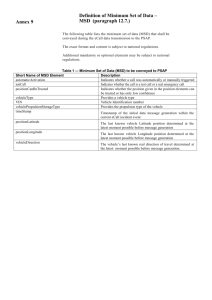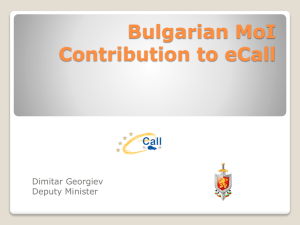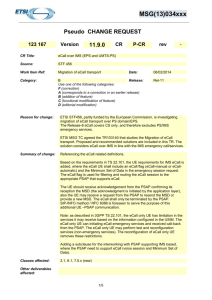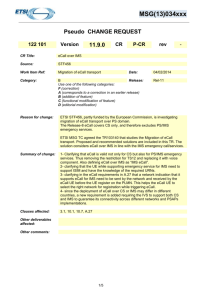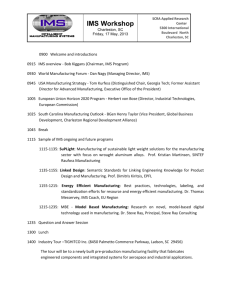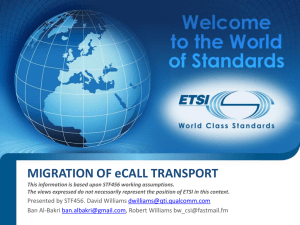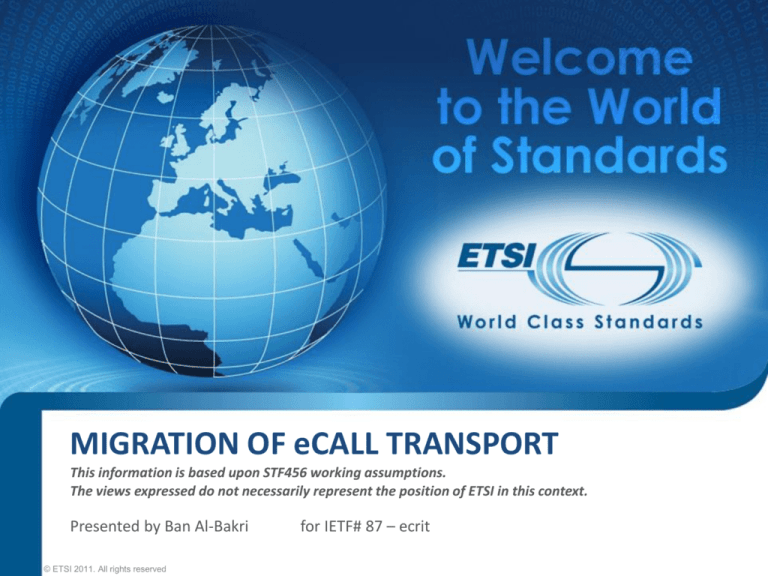
MIGRATION OF eCALL TRANSPORT
This information is based upon STF456 working assumptions.
The views expressed do not necessarily represent the position of ETSI in this context.
Presented by Ban Al-Bakri
© ETSI 2011. All rights reserved
for IETF# 87 – ecrit
Agenda
What is eCall?
How does eCall work?
STF -Project need
The objectives of STF456
What do we need to achieve in
IETF?
ACN and eCall
Related IETF drafts
2
© ETSI 2011. All rights reserved
What is eCall?
The European Commission has agreed to promote a harmonised panEuropean in-vehicle emergency call (e-Call) service that builds on the
location-enhanced emergency call E112 to improve the notification of
such accidents and ensure providing emergency assistance effectively to
save lives and reduce social burdens of road accidents.
In the event of a road accident, an eCall equipped vehicle will
automatically (or manually) establishes an emergency voice call that is
routed to the appropriate Public Safety Answering Point (PSAP).
The eCall equipped vehicle also sends an emergency message known as
the minimum set of data (MSD), including key information about the
accident, such as number of vehicle occupants, time, accurate location,
driving direction resulting from accurate satellite-based data and vehicle
description.
3
© ETSI 2011. All rights reserved
How does eCall work?
See http://www.icarsupport.eu/ecall/
4
© ETSI 2011. All rights reserved
STF - Project need
ETSI STF456, partly funded by the European Commission, is
investigating migration of eCall transport over IP Multimedia
Subsystem (IMS).
Current eCall is based on CS emergency call in GSM and UMTS networks.
LTE spectrum auctions are taking place in the EU and there will be
extensive LTE coverage before the implementation of eCall becomes
mandatory in 2015. There is no CS emergency call in LTE.
The longevity of GSM networks in the EU over the lifetime of vehicles is
uncertain and GSM spectrum is likely to be re-allocated for UMTS and/or
LTE.
A long term plan to deliver eCall over IP Multimedia Subsystem (IMS) in
LTE networks is desirable to benefit from availability and efficiency of the
resources .
5
© ETSI 2011. All rights reserved
The objectives of STF456
Among the objectives of STF 456 is to perform a
study and derive recommendations concerning
migration from 2G/3G to 4G based eCall systems
considering:
• Migration away from Circuit Switched emergency call towards VoIP
•
•
•
•
6
based emergency call/ IMS emergency call.
Routing eCall to the appropriate PSAP (eCall flag).
In-vehicle System (IVS) Minimum Set of Data (MSD) transport
mechanisms, and the means of transporting both MSD and potential
future eCall data with IMS.
Public safety Answering Point (PSAP) requirements and interfaces.
Support of eCall’s current and potential future requirements with
3GPP IMS emergency call.
© ETSI 2011. All rights reserved
What do we need to achieve in IETF?
eCall Identification and Routing to the appropriate
PSAP (supporting eCall)
• URNs to indicate the eCall (Manual vs. Automatic)
• URNs to indicate the eCall IVS Test call (Manual vs.
Automatic)
• Required:
• IANA registration for the following need to be confirmed:
URN 'urn:service:sos.ecall' - under the sub-services 'sos' registry.
Two sub-services are registered as well, namely:
urn:service:sos.ecall.manual
urn:service:sos.ecall.automatic
Also,
urn:service:test.sos.ecall.manual
urn:service:test.sos.ecall.automatic
7
© ETSI 2011. All rights reserved
What do we need to achieve in IETF?
Means of conveying the Minimum Set of Data (MSD)
( between the IVS and the PSAP)
• MSD is standardized by CEN (15722)
• MSD is standardized to be ASN.1 , of 140 bytes (different from other
•
•
•
•
8
possible ACN)
MSD to be routed to the same PSAP as the emergency voice call
Transmission of MSD has to be reliable
MSD is to be sent transparently between IVS and PSAP and is subject
to privacy
means to provide additional data concepts might be required in the
future, that should be considered in the design
© ETSI 2011. All rights reserved
What do we need to achieve in IETF?
Other considerations
• The time for the PSAP to forward the eCall to another PSAP/
•
•
•
•
emergency service should not exceed 2 seconds from when the
IVS receives notification that the PSAP has answered the call
The emergency service category (fire, ambulance, police, etc.. )
need to be provided to the PSAP operator in a standardised way
It shall be possible for the PSAP to send a confirmation to the
IVS that the MSD has been acted upon
It shall be possible for the PSAP to request the IVS to re-send its
most recent MSD
It shall be possible for the PSAP to instruct the IVS to terminate
the eCall
• It shall be possible for the PSAP to perform call-back
towards the IVS
9
© ETSI 2011. All rights reserved
ACN and eCall
ACN and eCall : similar objectives but different concepts
• Joining the requirements for ACN and eCall within a
common standard was attempted in 2007
• It failed to gain consensus because there were differences
in the concepts
• The Regulatory requirements in the EC and Russia are
implementing delivery of the ASN.1 PER elaborated MSD
• ASN.1 based eCall is being implemented in the 26 member
states of Europe, Russia, and New Zealand by legislation;
and is being considered in Australia and some of the states
that used to be in the USSR and have close links to Russia.
10
© ETSI 2011. All rights reserved
Related IETF drafts
Available IETF drafts should be taken into
consideration in relation to the value it may
provide, especially in reference to MSD
transfer for eCall over IMS.
• draft-rosen-ecrit-ecall-10
• draft-ietf-ecrit-additional-data-10
• draft-jesske-ecrit-ecall-urn-extension01.txt
11
© ETSI 2011. All rights reserved
Project Contacts for STF456
Project Leader
David Williams c_dwilli@qti.qualcomm.com
Technical expert
Ban Al-Bakri ban.albakri@gmail.com
Expert
Williams Robert bw_csi@fastmail.fm
12
© ETSI 2011. All rights reserved
Questions
Thank you for your attention
Questions?
13
© ETSI 2011. All rights reserved
Questions
14
© ETSI 2011. All rights reserved
“eCall for IMS” requirements
The following are selected requirements from 3GPP specification
TS22.101 that apply to UEs and networks designed to be able to
perform transfer of data during an emergency call (proposed
amendments to 3GPP TS 22.101 are underlined), and the aim is
to collect comments on possible impacts of the selected
requirements on IETF work.
The data may be sent prior to, in parallel with, or at the start of the voice
component of an emergency call.
IMS> the MSD is to be sent with the SIP INVITE signalling, or with a separate media
session.
Should the PSAP request additional data then this may be possible during
the established emergency call.
IMS> use any method that fulfils this requirement between the PSAP and the IVS .
15
© ETSI 2011. All rights reserved
“eCall for IMS” requirements
The realisation of the transfer of data during an emergency call shall
minimise changes to the originating and transit networks.
IMS> eCall for IMS is an IMS emergency call with the additional required data (MSD).
Both the voice and data components of the emergency call shall be routed
to the same PSAP or appropriate emergency call centre.
IMS> sending the MSD with the INVITE shall guarantee arriving the same PSAP.
eCall voice component (and other media if available) and the Minimum
Set of Data (MSD) shall be transported transparently and are subject to
privacy consideration.
IMS> MSD transfer should be transparent and subject to privacy; does carrying MSD in
INVITE message satisfy this requirement?? otherwise we may need a separate
session to send the MSD.
16
© ETSI 2011. All rights reserved
“eCall for IMS” requirements
In eCall for CS domain, Tthe transmission of the data shall be
acknowledged and if necessary data shall be retransmitted. In eCall for
IMS, it is required to make the transmission of data reliable.
IMS> is IMS based SIP signalling messages reliable enough?
The UE shall indicate at call setup if the emergency call will carry
supplementary data.
IMS> when the SIP INVITE message URN indicates eCall, then the PSAP expects the
MSD data to be received in the same message. Otherwise the eCall urn shall
indicate to the PSAP that additional data are to be received.
The UE shall contain an USIM application.
IMS> IMS registration can identify the user.
It shall be possible for the UE upon request from the user to initiate a call
to an operator designated non-emergency MSISDN or URN/URI for the
purpose of accessing test and terminal reconfiguration services.
IMS> do we need to define URNs for the test and reconfiguration services?
17
© ETSI 2011. All rights reserved
“eCall for IMS” requirements
Among the requirements for the transfer of
eCall Minimum Set of Data (MSD):
An IVS, or other UE designed to support eCall functionality, shall include in
the emergency call set-up an indication that the present call is either a
Manually Initiated eCall (MIeC) or an Automatically Initiated eCall (AIeC);
IMS>indication by URN that the eCall is triggered manual or automatic.
In case of eCall for CS domain,Tthe Minimum Set of Data (MSD) sent by
the In vehicle System (IVS) to the network shall not exceed 140 bytes;
IMS> there is no limitation on the MSD length carried with IMS messages. However, in
the future, if we plan on adding the FSD then the INVITE message may not be
appropriate and we may need additional session to be set-up.
18
© ETSI 2011. All rights reserved
“eCall for IMS” requirements
In eCall for CS domain,Tthe MSD should typically be made available to the
PSAP within 4 seconds measured from the time when end to end
connection with the PSAP is established;
IMS> what would be the right time in eCall for IMS? Probably not applicable
requirement if the MSD is carried over the SIP signalling (INVITE message),
otherwise if the MSD is carried over a separate session then we may need to define
the minimum required time.
Should the MSD component not be included in an eCall, or is corrupted or
lost for any reason, then this shall not affect the associated TS12
emergency call speech functionality.
IMS> if the MSD is corrupted or lost, the eCall for IMS voice set up and connection
should not be impacted.
19
© ETSI 2011. All rights reserved
“eCall for IMS” requirements
Based on national regulations, PLMNs should may be configured to make
use of eCall indicators, received in the emergency call set-up, to
differentiate eCalls from other TS12 emergency calls.
IMS> the CSCF, if configured, should use the information in the URN to identify the
eCall and route it to the appropriate PSAP according to the configurations provided
by the MNO (based on local regulation). An alternative is to allow the emergency
IP network to perform the differentiation of eCall from other emergency services
rather than the MNO.
Where the eCall indicators are not supported by the serving network, the time
needed for the PSAP (eCall modem in case of eCall for CS domain)(when used) to
differentiate between eCalls and other TS12 emergency calls, before routing the
call to an PSAP operator, shall not exceed 2 seconds from when the IVS receives
notification that the PSAP has answered the call.
IMS> if the PSAP understands the URN services it could perform this. So what is the time required
for the PSAP to route the eCall to the right emergency operator in IP based network?
20
© ETSI 2011. All rights reserved
“eCall for IMS” requirements
The PSAP shall be given an indication that the incoming call is an eCall.
IMS> this indication is by sending the eCall specific URN.
Throughout the duration of the emergency call and following receipt of the MSD by
the PSAP:
It shall be possible for the PSAP to send a confirmation to the IVS that the MSD has
been acted upon.
IMS> use any method that fulfils this requirement between the PSAP and the IVS.
It shall be possible for the PSAP to request the IVS to re-send its most recent MSD.
IMS> this can be using SIP messages within the session or other methods allowing data
communication between the PSAP and the UE.
It shall be possible for the PSAP to instruct the IVS to terminate the eCall.
IMS> the PSAP can terminate the eCall, or the PSAP, using SIP messages within the session or
other methods allowing data communication, to request the eCall UE to terminate the
emergency call
21
© ETSI 2011. All rights reserved
Analysis
eCall Flag:
• Used for routing, eCall identification, and
•
differentiation of eCall (Manual or Automatic)
Required:
• IANA registration for the following need to be confirmed:
URN 'urn:service:sos.ecall' - under the sub-services 'sos' registry.
Two sub-services are registered as well, namely:
urn:service:sos.ecall.manual
urn:service:sos.ecall.automatic
NOTE: additional urns may be required for the test and reconfiguration services.
22
© ETSI 2011. All rights reserved
Analysis
Voice and any additional media sessions:
Any voice, video, or real-text communication will be negotiated over IMS using the
Session Description Protocol (SDP), and the actual media stream will then take
place in RTP packets. This follows the same procedures as for Voice and
Multimedia IMS emergency services.
Caller identity:
The Calling line identification is required allowing the PSAP to call back the eCall
UE. This is provided similar to any IMS emergency services call back feature.
Location information of the vehicle
23
The MNO provides location information in the SIP INVITE message as for IMS
emergency calls based on their location services supported features. This location
information may be used for routing and is made available to the PSAP.
Since the MSD includes location information as determined by the IVS, IMS eCall
provides the PSAP with the MSD (where the MSD is carried transparently), hence
an additional source of location is provided to the PSAP.
© ETSI 2011. All rights reserved
Analysis
Transfer of MSD data (MSD data is defined in CEN Technical
Specification (CEN 15722)
Several options exist to transport the MSD;
1-Carried inband within the packet voice session, however the PSAP solution is eCall
modem based (CS based). This solution adds delays and design complexity, where
the mapping and conversion of PS to CS (eCall modem based) is to be performed
in the IMS Media-Gateway. Furthermore, the transmission of the MSD via inband
within a packet-switched voice session can be delayed or degraded by VoIP
processing functions such as time-warping in the VoIP de-jitter buffers.
2-Carried inband within the packet voice to transmit data from a vehicle to a PSAP.
This solution adds complexity, where it requires multiplexing / filtering at the end
points. Furthermore, the performance of MSD delivery over inband within the
packet-switched voice session can be degraded by any time-warping operations
performed in the VoIP de-jitter buffers at the end points.
24
© ETSI 2011. All rights reserved
Analysis
3-Carried on by the IMS signalling as:
a) sending the MSD in the INVITE message as described in Internet Protocol-based In-Vehicle
Emergency Call: draft-rosen-ecrit-ecall-08. This method guarantees that the destination receiving the
invite message receives the MSD inband at the same time.
b) indicating the capability in the INVITE message, and using SIP specific messages (example Real Time
Streaming Protocol (RTSP)- RFC 4567) that takes the same route while applying additional security
mechanism, however complexity could arrive in security key source and coordination.
25
4-Carried out of band via a separate media session with security encryption
considerations (using TCP connection) between the UE and the PSAP, this method
may add additional delay, complexity and cost since it requires a TCP connection.
5-Using out of band as for example Message Session Relay Protocol (MSRP) - RFC
4975, however it is not clear if all operators implement this protocol in their
networks.
6-Carried over SMS over IMS; this option is not found advantageous or favourable
since the arrival of SMS in time to the same PSAP where the voice service is
connected cannot be guaranteed. Also emergency SMS, with high priority, may not
be supported in all networks.
The preferred solution is to implement 3a) considering the available draft-rosenecrit-ecall-08 as a starting point.
© ETSI 2011. All rights reserved
Analysis
Additional open issues:
It is also possible to define one URN 'urn:service:sos.ecall' and the PSAP is to
differentiate if the eCall is manual or automatic based on the content of MSD. This
reduces the impact on IMS where the routing is performed by the PSAP, however on
the other hand it is a limitation for the configuration of routing eCalls (manual and
automatic) to different PSAPs (or filtering points) as required by some country’s
authorities. Different countries have different PSAP configurations and this needs to be
taken into consideration.
It was also proposed that required routing of eCalls to the appropriate PSAPs should be
performed by the Emergency service IP network (ESInet) and not the PLMN. This
ensures no impact on IMS network in this respect.
Available IETF drafts should also be taken into consideration in relation to the value it
may provide, especially in reference to MSD transfer for eCall over IMS.
• draft-rosen-ecrit-ecall-08
• draft-ietf-ecrit-additional-data-09
• draft-jesske-ecrit-ecall-urn-extension-00.txt
26
© ETSI 2011. All rights reserved
Information about ETSI and funding partners
About ETSI:
ETSI produces globally-applicable standards for Information and Communications
Technologies (ICT), including fixed, mobile, radio, converged, broadcast and internet
technologies and is officially recognized by the European Commission as a European
Standards Organization. ETSI is a not-for-profit organization whose 700 ETSI member
organizations benefit from direct participation and are drawn from 60 countries worldwide.
For more information, please visit: www.etsi.org
About ETSI Specialist Task Forces (STF):
STFs are teams of highly-skilled experts working together over a pre-defined period to draft
an ETSI standard under the technical guidance of an ETSI Technical Body and with the support
of the ETSI Secretariat. The task of the STFs is to accelerate the standardization process in
areas of strategic importance and in response to urgent market needs. For more information,
please visit: http://portal.etsi.org/stfs/process/home.asp
and, for STFs funded by EC/EFTA:
The work carried out here is co-financed by the EC/EFTA in response to the EC’s ICT
Standardisation Work Programme.
© European Telecommunications Standards Institute, 2013. All rights reserved.
No part may be reproduced except as authorized by written permission.
The copyright and the foregoing restriction extend to reproduction in all media.
27
© ETSI 2011. All rights reserved

